铁路客运英语教案
《铁路客运英语》五标准版文档
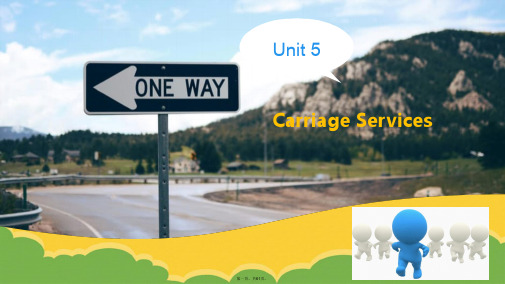
第十九页,共61页。
Opening Your Mouth
20
English for work situation
1. Our train is half an hour late. 本次列车晚点(wǎn diǎn)半个小时。 2. The train is on schedule. 列车准点运行。 3. May I open the window? 我可以打开窗户吗? 4. Close the window, please. 请关上窗户。 5. Excuse me, smoking is not allowed in the compartment. 对不起,车厢内不准吸烟。 6. If you do want to smoke, please go to the joint between the carriages. 如果您实在想抽烟,请到车厢连接处。
3. 医药箱 ___m__e_d_ic_i_n_e_c_a_b_in_e_t____ 4. 清洁袋 _________sa_n_i_ta_r_y_b_a_g_____
5. 果皮盒 ____________________ 6. 急救(jíjiù)人员 ____________________
garbage tray
第四页,共61页。
过渡页
TRANSITION PAGE
Warming Up
第五页,共61页。
Warming Up
6
A. Look at the following pictures and match them with their English names.
b
a
d
c
a. luggage rack
第十七页,共61页。
铁路客运英语教案设计2

W2:I hate the way people spit and litter. It really turns me off.
11.C:What do you find interesting about life in China?
W1:There are so many people and so many different from western culture.
W1:China was much more modern than I expected.
The cities are filled with skyscrapers.
W2:It`s very different from what I expected. It`s not at all like what I thought.
12.C:Where have you been?
W1:I`ve been to Beijing and Shanghai. They are very impressive.
今天我们学习了中国的文化,中国人的相关表达及对话,同学们一定要口说,开口练,否则学的英语就是哑巴英语,作为服务行业的工作人员,英语口语也是一门非常有用的知识与能力。
4.C:How do you like the Great Wall?
W1:It`s the most amazing thing I`ve ever seen!
5.C:What do you think of the Forbidden City?
W1:I history.
9.C:What do you like best about China?
W:The hospitality of the Chinese.
铁路客运英语教案
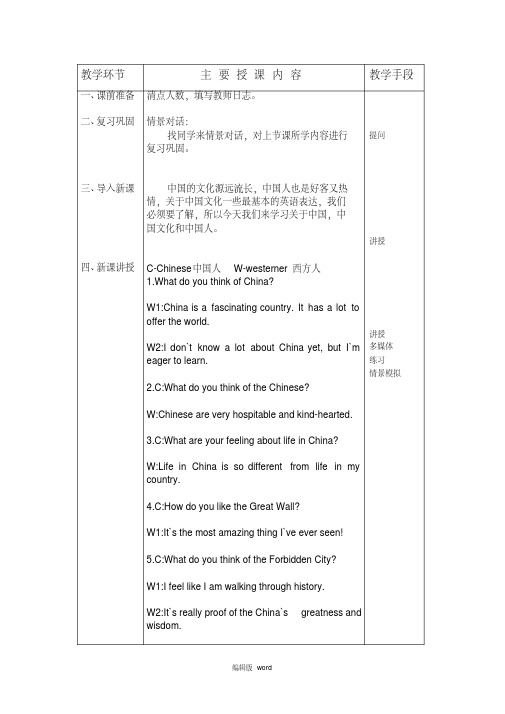
教学环节主要授课内容教学手段一、课前准备二、复习巩固三、导入新课四、新课讲授清点人数,填写教师日志。
情景对话:找同学来情景对话,对上节课所学内容进行复习巩固。
中国的文化源远流长,中国人也是好客又热情,关于中国文化一些最基本的英语表达,我们必须要了解,所以今天我们来学习关于中国,中国文化和中国人。
C-Chinese 中国人W-westerner 西方人1.What do you think of China?W1:China is a fascinating country. It has a lot tooffer the world.W2:I don`t know a lot about China yet, but I`meager to learn.2.C:What do you think of the Chinese?W:Chinese are very hospitable and kind-hearted.3.C:What are your feeling about life in China?W:Life in China is so different from life in my country.4.C:How do you like the Great Wall?W1:It`s the most amazing thing I`ve ever seen!5.C:What do you think of the Forbidden City?W1:I feel like I am walking through history.W2:It`s really proof of the China`s greatness and wisdom.提问讲授讲授多媒体练习情景模拟6.C:What do you want to know about China?W1:I want to know more about traditional Chinese medicine.W2:I want to know about opportunities for my business.W3:I really want to know more about the English education in China.7.C:What attracts you the most about China?W1:The ancient culture, the friendly people and the terrific food.W2:The exciting atmosphere of change and development.8.C:What was your impression of China?W1:China was much more modern than I expected. The cities are filled with skyscrapers.W2:It`s very different from what I expected. It`s not at all like what I thought.9.C:What do you like best about China?W:The hospitality of the Chinese.W2:The history and unique features of its different Cities.10.C:What do you dislike most about China?W1:The pollution.W2:I hate the way people spit and litter. It really turns me off.11.C:What do you find interesting about life in China? 讲授多媒体四、课堂小结五、布置作业六、课后反思W1:There are so many people and so many different from western culture.W2:Ancient culture and modern development exist side by side.W3:There are so many different cities and so many different customs. Every city has a unique personality.12.C:Where have you been?W1:I`ve been to Beijing and Shanghai. They are very impressive.今天我们学习了中国的文化,中国人的相关表达及对话,同学们一定要张口说,开口练,否则学的英语就是哑巴英语,作为服务行业的工作人员,英语口语也是一门非常有用的知识与能力。
《铁路客运服务英语》电子教案 其他服务 Unit3-Wenzhou train collision
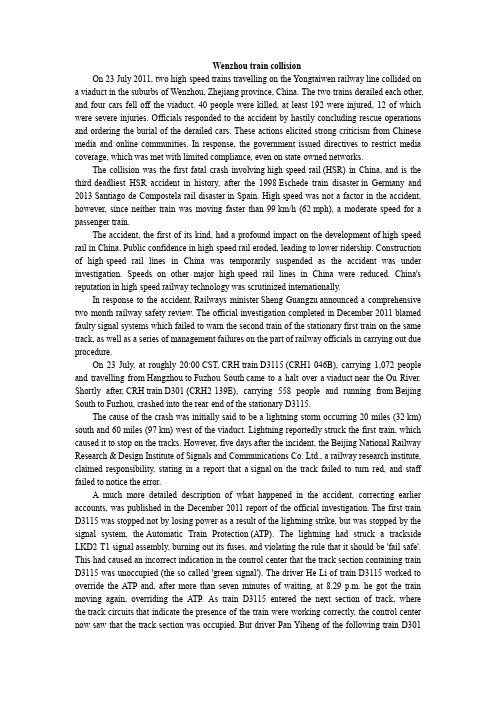
Wenzhou train collisionOn 23 July 2011, two high-speed trains travelling on the Yongtaiwen railway line collided on a viaduct in the suburbs of Wenzhou,Zhejiang province,China. The two trains derailed each other, and four cars fell off the viaduct. 40 people were killed, at least 192 were injured, 12 of which were severe injuries. Officials responded to the accident by hastily concluding rescue operations and ordering the burial of the derailed cars. These actions elicited strong criticism from Chinese media and online communities. In response, the government issued directives to restrict media coverage, which was met with limited compliance, even on state-owned networks.The collision was the first fatal crash involving high-speed rail(HSR) in China, and is the third-deadliest HSR accident in history, after the 1998Eschede train disaster in Germany and 2013Santiago de Compostela rail disaster in Spain. High speed was not a factor in the accident, however, since neither train was moving faster than 99km/h (62mph), a moderate speed for a passenger train.The accident, the first of its kind, had a profound impact on the development of high-speed rail in China. Public confidence in high-speed rail eroded, leading to lower ridership. Construction of high-speed rail lines in China was temporarily suspended as the accident was under investigation. Speeds on other major high-speed rail lines in China were reduced. China's reputation in high-speed railway technology was scrutinized internationally.In response to the accident,Railways minister Sheng Guangzu announced a comprehensive two-month railway safety review. The official investigation completed in December 2011 blamed faulty signal systems which failed to warn the second train of the stationary first train on the same track, as well as a series of management failures on the part of railway officials in carrying out due procedure.On 23 July, at roughly 20:00CST,CRH train D3115(CRH1-046B), carrying 1,072 people and travelling from Hangzhou to Fuzhou South came to a halt over a viaduct near the Ou River. Shortly after,CRH train D301(CRH2-139E), carrying 558 people and running from Beijing South to Fuzhou, crashed into the rear-end of the stationary D3115.The cause of the crash was initially said to be a lightning storm occurring 20 miles (32km) south and 60 miles (97km) west of the viaduct. Lightning reportedly struck the first train, which caused it to stop on the tracks. However, five days after the incident, the Beijing National Railway Research & Design Institute of Signals and Communications Co. Ltd., a railway research institute, claimed responsibility, stating in a report that a signal on the track failed to turn red, and staff failed to notice the error.A much more detailed description of what happened in the accident, correcting earlier accounts, was published in the December 2011 report of the official investigation.The first train D3115 was stopped not by losing power as a result of the lightning strike, but was stopped by the signal system, the Automatic Train Protection(ATP). The lightning had struck a trackside LKD2-T1 signal assembly, burning out its fuses, and violating the rule that it should be 'fail-safe'. This had caused an incorrect indication in the control center that the track section containing train D3115 was unoccupied (the so-called 'green signal'). The driver He Li of train D3115 worked to override the ATP and, after more than seven minutes of waiting, at 8.29 p.m. he got the train moving again, overriding the ATP. As train D3115 entered the next section of track, where the track circuits that indicate the presence of the train were working correctly, the control center now saw that the track section was occupied.But driver Pan Yiheng of the following train D301had already been given instructions to proceed onto the section of track where D3115 had been stopped, when the control center had a false indication that the track was unoccupied. Despite a message from the control center that D301 should proceed with caution, less than half a minute later train D301 running at 99km/h (62mph) collided with train D3115.The fifteenth and sixteenth coaches at the rear of D3115 and the front four coaches of D301 were derailed — four coaches fell off the viaduct. Three carriages came to rest horizontally on the ground below while the fourth came to rest vertically, one end on the ground and one end leaning against the viaduct.The medical teams responding to the accident consisted of staff from Zhejiang No. 1 Hospital, Zhejiang No. 2 Hospital, Zhejiang Provincial People's Hospital and Taizhou Hospital.[17]The evening of the event, 500Wenzhou residents gave blood in response to early radio appeals by the local blood bank.A survivor, Liu Hongtaohe, recalled that "the train suddenly shook violently, casting luggage all around. Passengers cried for help but no crew responded" in an interview with China Central Television.[22]CCTV reported on 25 July that the Railways Ministry had declared that 39 people were killed and 192 injured.[7]Two-year-old Xiang Weiyi was the last person rescued, 21hours after the train crash.[23]Her parents had been killed in the crash.Soon after the accident, the damaged railway carriages were seen being broken apart by backhoes and buried nearby.[24]Chinese regulatory bodies gave as the preliminary cause a lighting strike on one of the line’s overhead power lines.The U.S. Embassy in Beijing said on 25 July that two U.S. citizens were among the dead.The Italian consulate of Shanghai said that an Italian citizen was among the dead:Assunta Liguori, a 22-year-old student of the Università degli studi di Napoli L'Orientale. Liguori was travelling with Giovanni Pan, a 23-year-old student from L'Orientale, of Chinese origin.On 28 December 2011 the official accident investigation report presented to the State Council was released to the public.According to this report, the accident occurred due to severe defects in the design of control center equipment, lax equipment inspection and failure to adequately respond to equipment malfunction caused by lightning. The report names 54 officials as bearing responsibility for the accident and the botched rescue effort. The most senior official implicated in the report is former minister Liu Zhijun, who had been detained on corruption charges before the accident, but nonetheless is accused of improperly raising the operating speed of the Ningbo-Taizhou-Wenzhou Railway and compressing the construction schedule of the railway, which resulted in curtailed safety inspection of the line. He is also blamed for failing to assign proper duties to a newly created office within the MOR to oversee passenger-dedicated high-speed railway lines, failing to resolve bureaucratic overlap in the oversight of HSR safety within the Ministry that weakened regulatory oversight, and failing to direct subordinates to institute proper review and inspection procedures for newly developed signaling equipment, which led the defective LKD2-T1 signal equipment to be put into operation. Other senior MOR officials cited include deputy minister Lu Dongfu, MOR chief engineer He Huawu and former MOR deputy chief engineer Zhang Shuguang.The report also assigns fault to executives and engineers of the China Railway Signal & Communications Corp., which designed, produced and installed the defective equipment, executives of the Jingfu Railway(Anhui) Corporation, which permitted the faulty equipment to be installed improperly in breach of the contractual terms.Numerous officials of the ShanghaiRailway Bureau, which operates the line, are also singled out for blame including former bureau chief Long Jing, who was fired shortly after the accident, as well as deputy bureau chief, Wang Feng, who ordered that wrecked train carriages be buried in pits dug on-site.The chief and deputy chief of Wenzhou South Station are faulted for inadequate oversight of employees. Among the most junior persons cited is Zang Kai, a worker at Wenzhou South Station who discovered signal failure on the D3212 Train but, in breach of protocol, failed to file a log report of the malfunction and did not communicate with the D301 Train.。
铁路客运英语一共59张课件

8. I am very happy to see you. 我很高兴见到您。
OpenigYourMthⅠ.Usflx
Opening Your Mouth
9. I am delighted to know you.
认识您很高兴。
10. Hello! How are you?
嗨!您怎么样?
11. How is everything?
见到您很高兴。
4. It’s very nice to meet you.
见到您真的很高兴。
5. It’s a pleasure to meet you.
认识您深感荣幸。
6. It’s good to see you again. 再次见到您很高兴。
7. I am very pleased to see you. 遇到您,我很高兴。
seat class train number
Warming Up
C. Match the Chinese in column A with their corresponding English in column B.
上铺
中铺
软卧
硬卧 商务座
特等座
下铺
高级软卧
一等座 二等座
软座
硬座
无座
VIP class seat
请坐。
7. Take care and have a safe trip.
保重,旅途平安。
8. I hope you will enjoy your stay here. 希望您能在这过得开心。
9. Is this your first trip to Beijing?
这是您第一次来北京吗?
《铁路客运英语》课件
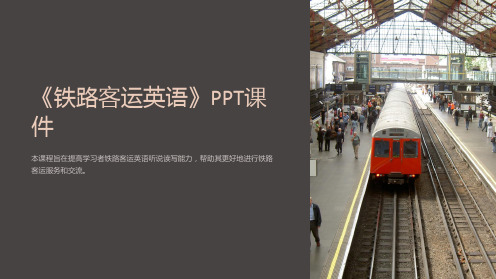
本课程旨在提高学习者铁路客运英语听说读写能力,帮助其更好地进行铁路 客运服务和交流。
欢迎和介绍
问候
热烈欢迎大家参加本课程!
交流
希望学习者们积极参与讨论,共 同提高。
介绍
我是本课程的讲师,专注于铁路 客运英语培训多年。
铁路客运基础知识
1
车站和售票
了解车站的设施、售票的方式,掌握火车票种类和购票注意事项。
1 课程总结
对所学知识点进行概括,反思学习情况,提出反馈和建议。
2 答疑解惑
解答学员在学习中遇到的问题,并提供延伸资源和拓展阅读。
2
列车和座位
学会车厢和座位号码的表示方法,以及通行的旅客礼仪。
3
车票和行李
学习车票使用和验票流程,携带行李的规定和注意事项。
铁路客运日常用语
乘客登车
学会用英语询问和告知开车时间、方向、始终站 等基本信息。
停靠站和转车
学习如何用英语表述停靠站名、转车线路和方向 等信息。
站务员指引
掌握对站务员询问的应答方式,按时换乘和通行 的礼仪。
到达站和下车
了解英语表达下车的常用说法和与车站工作人员 ຫໍສະໝຸດ 流的技巧。铁路客运紧急情况应对
1
抢劫和安全
2
了解铁路安全和防范知识,遇到紧急情
况的自救和报警方法。
3
火灾和疏散
学习火车上遭遇火灾的应对策略和紧急 疏散方法。
自然灾害和救援
了解自然灾害对铁路运输的影响,以及 铁路救援部门的职责和措施。
课程总结与答疑
铁路客运英语教案设计
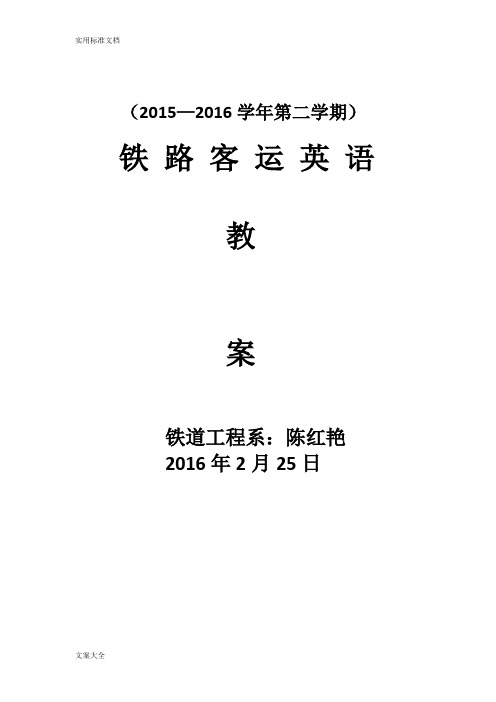
B:Thanks , see you again.
谢谢,再见!
A:Have a safe trip.
祝你一路平安!
Introduction介绍
A:May I know your name?
可以告诉我您的名字吗?
B:My name is Tom.
我的名字是汤姆。
今天我们学习了Unit One Seat Class的单词,以及简单的短对话。希望同学们课后多加练习。
Soft Sleeper(Rw)
There are both 2-bed berth and 4-bed berth soft sleepers.4-bed berths are the standard soft sleepers. Due to the higher price ,it is easier to book a ticket for a soft sleeper than it is for a hard sleeper. The beds are more and more comfortable and theenvironmentis much quiet inside. The berths are lockable.
清代我问候您的家人。
4.Mini Talks短对话
Greetings问候
A:welcome to Beijing!
欢迎来到北京。
B:Thank you !
谢谢。
A:Where are you form?
你来自哪里?
B:I am from America.
我来自美国。
A:Is this your first trip to Beijing?
铁路客运英语教案

铁路客运英语教案铁路客运英语教案篇一:铁路客运英语AA.How manyB. How oldC. HowD. Who( ) 7. I must_________ school.A. to goB. goC. to go to.D. go to() 8. Please give the book _________ Mr White A. for B. in C. toD.with() 9. Let _________ play games with you. A. weB. us C. our D. ours ( ) 10. I can't _________ my pen.A.to findB. findC. look atD. look like四翻译下列句子(10*4=40) 1. Welcome to China ! 2. Wish you a pleasant journey ! 3. I am a station attendant. 4. Sorry to have you waiting. 5. When does the train leave for Guangzhou ?A卷第3页共4页6. Please show me your ticket.7. Please don’t lean out of the window .8. 请不要向窗外扔东西。
9. 谢谢你的劝告。
10. 让我帮你拿行李吧。
A卷第4页共4页铁路客运英语教案篇二:铁路客运英语A卷2014---2015学年第二学期城轨专业《客运英语》课期末考试试卷A卷( orange.) 1. What's this in English? It's _______ orange. It's ______ big:级班:名姓:业专一找出划线部分发音不同的选项。
铁路客运英语 教案 unit 2 Ticket Office (2)

2)教师提问:(1) How do we refund our ticket?
(2)How do we change our ticket?
Step2:Presentation
1)多媒体展示:用一段视频展示外国人去车站改签车票的对话场景。
好的。给您护照、车票和零钱。
P:Thank you.
谢谢。
T:It’s my pleasure.
不用谢。
2)教师讲解重点单词的发音和意思。
Step 3: Practice
1)请学生自主朗读对话不少于3遍
2)请3组学生代表站起来朗读对话。
Step 4: Production
请学生将对话改写,然后进行Role-play.
可以,让我看下您的车票。还没到开车时间。根据有关规定,您得支付票价20%的退票费。
P:OK.
好的。
T:You still need to show us your valid ID certificate.
您需要出示一下有效身份证件。
P:Here you are.
给您。
T:Thank you.Here is your refund.
您好。请问我的车票可以办理改签吗?
T:Let me look at your ticket.Sorry,you cannot refund your ticket after the train leaves,but you can change your ticket within two hours after departure.
让我看看您的车票。对不起,开车后的车票不能办理退票。但是可以在开车后2小时内办理改签。
铁路客运英语教学大纲
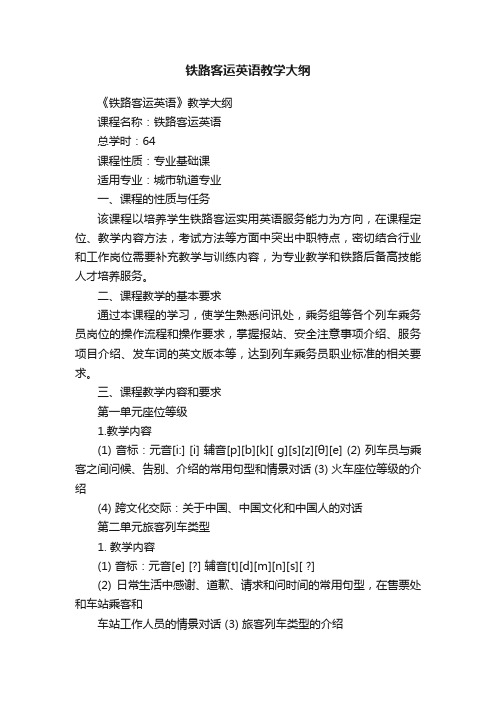
铁路客运英语教学大纲《铁路客运英语》教学大纲课程名称:铁路客运英语总学时:64课程性质:专业基础课适用专业:城市轨道专业一、课程的性质与任务该课程以培养学生铁路客运实用英语服务能力为方向,在课程定位、教学内容方法,考试方法等方面中突出中职特点,密切结合行业和工作岗位需要补充教学与训练内容,为专业教学和铁路后备高技能人才培养服务。
二、课程教学的基本要求通过本课程的学习,使学生熟悉问讯处,乘务组等各个列车乘务员岗位的操作流程和操作要求,掌握报站、安全注意事项介绍、服务项目介绍、发车词的英文版本等,达到列车乘务员职业标准的相关要求。
三、课程教学内容和要求第一单元座位等级1.教学内容(1) 音标:元音[i:] [i] 辅音[p][b][k][ g][s][z][θ][e] (2) 列车员与乘客之间问候、告别、介绍的常用句型和情景对话 (3) 火车座位等级的介绍(4) 跨文化交际:关于中国、中国文化和中国人的对话第二单元旅客列车类型1. 教学内容(1) 音标:元音[e] [?] 辅音[t][d][m][n][s][ ?](2) 日常生活中感谢、道歉、请求和问时间的常用句型,在售票处和车站乘客和车站工作人员的情景对话 (3) 旅客列车类型的介绍(4) 跨文化交际:关于不同国家的情况的对话第三单元严禁携带危险品宣传1. 教学内容(1) 音标:元音[?] [?:] 辅音[f][v][ ?][ ?][h][r](2) 日常生活中谈论身体健康和提建议的常用句型,在列车上乘客和列车员之间的情景对话(3) 列车上严禁携带危险品的宣传词(4) 跨文化交际:美国和中国人爱好、家庭观念的不同第四单元客车1.教学内容(1) 音标:元音[?] [?:] 辅音[ts][dz][ t?][ d?][tr][dr] (2) 接车用语、在贵宾候车室服务员和乘客的情景对话 (3) 客车的种类(4) 跨文化交际:中国和其他国家不同的饮食第五单元上行和下行1.教学内容(1) 音标:元音[a] [?] [u] [u:] 辅音[l][j][ w](2) 有关车站设备和服务、询问车票的常用句型和情景对话 (3) 上行和下行第六单元北京西站1.教学内容(1) 音标:双元音[ei] [?u] [u] [ai] [au] [?i] [i?] [??] [u?] (2) 在行李托运处乘客和工作人员的情景对话(3) 北京西站的简介(4) 跨文化交际:中国人和西方人在礼仪方面的不同点第七单元青藏铁路1.教学内容(1) 重读开音节和重读闭音节的读音规则 (2) 有关列车的一般用语(3) 青藏铁路的简介(4) 跨文化交际:北京的名胜古迹和京剧的简介第八单元列车长1.教学内容(1) 句子的重音、升调和降调(2) 在列车行驶过程中乘客和列车员的情景对话 (3) 列车长的职责(4) 跨文化交际:英国的社交礼仪和与西方人交谈的基本礼仪第九单元上海磁浮列车1.教学内容(1) 英语口语中的意群和停顿的规则(2) 在餐车和失物招领处的情景对话、列车到站前列车员要说的话的常用句型 (3) 上海磁浮列车的简介(4) 跨文化交际:中国人和西方人体态语的不同点四、教学时数分配序号教学内容学时学时分配讲课实验(上机、实训)习题课、讨论课课程设计(大作业)1第一单元座位等级 6 2第二单元旅客列车类型 6 3第三单元严禁携带危险品宣传6 4第四单元客车 6第五单元上行和下行 65第六单元北京西站 66第七单元青藏铁路 67第八单元列车长 68第九单元上海磁浮列车 69复习10小计64五、考核方法1.本课程为考查课,考核方式采闭卷考试方式,2.课程考核:平时(40%)+期末理论考试(60%)。
铁路客运英语教案全部
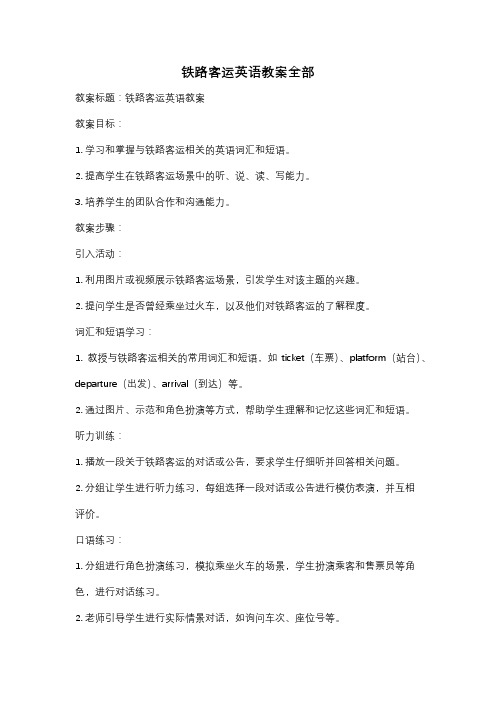
铁路客运英语教案全部教案标题:铁路客运英语教案教案目标:1. 学习和掌握与铁路客运相关的英语词汇和短语。
2. 提高学生在铁路客运场景中的听、说、读、写能力。
3. 培养学生的团队合作和沟通能力。
教案步骤:引入活动:1. 利用图片或视频展示铁路客运场景,引发学生对该主题的兴趣。
2. 提问学生是否曾经乘坐过火车,以及他们对铁路客运的了解程度。
词汇和短语学习:1. 教授与铁路客运相关的常用词汇和短语,如ticket(车票)、platform(站台)、departure(出发)、arrival(到达)等。
2. 通过图片、示范和角色扮演等方式,帮助学生理解和记忆这些词汇和短语。
听力训练:1. 播放一段关于铁路客运的对话或公告,要求学生仔细听并回答相关问题。
2. 分组让学生进行听力练习,每组选择一段对话或公告进行模仿表演,并互相评价。
口语练习:1. 分组进行角色扮演练习,模拟乘坐火车的场景,学生扮演乘客和售票员等角色,进行对话练习。
2. 老师引导学生进行实际情景对话,如询问车次、座位号等。
阅读理解:1. 分发一篇关于铁路客运的文章,要求学生阅读并回答相关问题。
2. 分组进行小组讨论,学生分享自己的阅读理解和观点。
写作练习:1. 要求学生写一篇关于铁路客运的短文,包括自己的乘车经历、感受和建议等。
2. 学生互相交换短文,进行修改和反馈。
团队合作活动:1. 将学生分成小组,要求每个小组设计一个铁路客运场景的角色扮演活动。
2. 每个小组进行表演,并互相评价其他小组的表演。
总结和评价:1. 老师对学生的表现进行总结和评价,给予肯定和建议。
2. 学生也可以对自己的学习情况进行自我评价,并提出改进的建议。
扩展活动:1. 邀请一位铁路工作人员来学校进行讲座,介绍铁路客运的相关知识。
2. 安排学生参观当地的火车站,亲身体验铁路客运的过程。
教案评估:1. 观察学生在词汇和短语学习、听力训练、口语练习、阅读理解和写作练习等环节的表现。
铁路客运英语 教案 unit 5 Board the Train (1)
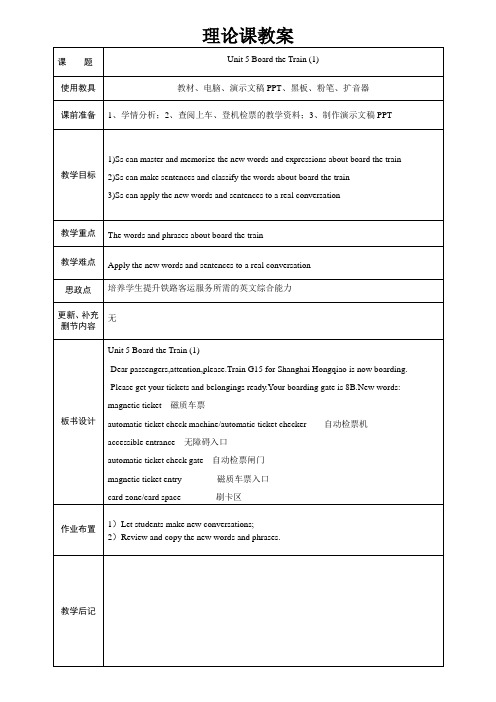
是的。恐怕您来得太晚了。开车前3分钟就已经停止检票了。
P:I take your point,but what shall we do now?
Dear passengers,your attention,please!Tickets for Train D4 from Shenyang North to Beijing are now checking.Passengers for Train D4,please check your tickets at Gate B9 with all your belongings,and board the train at platform 10.
Lead-in
1、How toboard the station?
2、What kind of situation will you meet?
Presentation
Dialogue 1
(Announcement for Check in)
Dear passengers,attention,please.Train G15 for Shanghai Hongqiao is now boarding.The train is now standing at Platform 3 and will depart in 20 minutes.Please get your tickets and belongings ready.Your boarding gate is 8B.Thank you for your attention.
《铁路客运服务英语》电子教案 列车服务 Unit2-China Train Types

China Train TypesHigh-Speed RailG ("Gaosu", High Speed Train)This is a series for long-distance high-speed trains. These are generally the fastest services available and the top speed can be up to 350km/h (217mph) but are limited to 300km/h (186mph) operationally. As such they generally serve only lines capable of such speeds. G1–G5998 is used for the trains that run in more than one railway bureau's territory, while G6001–G9998 is used for the trains that run in only one railway bureau's territory.China Standard EMU in Dalian North Railway StationD ("Dongche", EMU Train)This series has become available after the sixth rise in speed of the railway on April 18, 2007. The top speed will be up to 250km/h but are limited to 200km/h operationally. These trains are powered using CRH series electric multiple units(EMUs) named "Harmony" (Chinese:和谐号, Hexiehao). D1–D3998 for the trains running through two or more railway bureaus, D4001–D9998 for the trains running within one railway bureau. While most "D" Services run on high-speed rails, a limited number of services do travel over conventional railways at conventional speeds for a portion of their journey to connect some cities off the high-speed network.As of 2009, D-series trains provide fast frequent service between main cities in China. For example:Beijing–Shijiazhuang(2 hours travel time),Taiyuan(3 hours travel time),Handan(3–3.5 hours travel time),Zhengzhou(5 hours travel time).Guangzhou–Shenzhen(1 hour travel time)Shanghai–Nanjing(2 hours travel time),Hangzhou(1.5 hours travel time), some continuing to destinations beyond such as Zhengzhou and Hankou.Besides, a few other nighttime D trains go to more remote destinations, such as the services between Shanghai and Beijing.CRH3 EMU Train PictureC ("Chengji", Intercity High-Speed Train)This series has become available after August 1, 2008 with the opening of Beijing–Tianjin Intercity Rail. It represents the EMU trains with shorter travel distances, and mainly running within one railway bureau. The top speed is 350km/h (e.g. Beijing-Tianjin) but most operate from 160–250km/h. C1–C1998 for the trains running through two or more railway bureaus, C2001–C9998 for the trains running within one railway bureau. Some of these services run more as commuter trains to/from satellite cities surrounding major urban centres or from downtown to the airport, as at Lanzhou.A Intercity High-Speed Train from Beijing to TianjinConventional RailZ ("Zhida", Non-Stop Express)'Z' trains, though their name in Chinese (Chinese:直达; pinyin:Zhídá) technically implies a "non-stop" overnight train, some of these trains have several stops between the two stations. The majority have both soft sleepers and hard sleepers, while some Z trains have only soft sleepers. The top speed is 160km/h. It uses the numbers Z1-Z9998 without regard to the number of railway bureaus entered.This series became available after the fifth rise in speed of the railway on April 18, 2004. Early on (2004–2006), all but one of the Z-series trains had either Beijing or Beijing West stationas their destination or origin. As of 2009, Z-series trains also operated along the Yangtze Valley as well, providing overnight service from Wuhan to Shanghai,Hangzhou,Ningbo andShenzhen.An non-stop express train running between Beijing and Jilin T ("Tekuai", Express)This series of trains have a limited number of stops along their routes, only in major cities, or in some instances stops for switching the driver or locomotive. The top speed is 140km/h. T1–T4998 for the trains running through two or more railway bureaus, T5001–T9998 for the trains running within one railway bureau. The standard pronunciation on the railway system is "Te"(特) in Chinese.Express Train T27/28 running between Beijing West and Lhasa K ("Kuaisu", Fast)This series of trains stop at more stations than T-series. The top speed is 120km/h. The standard pronunciation on the railway system is "Kuai"(快) in Chinese. K1–K6998 are used for the trains that run in more than one railway bureau, while K7001 to K9998 will be used for the trains that run in only one railway bureau.After April 18, 2004, N-series trains, which represent fast trains travelling exclusively within one railway bureau, were derived from K-series. Then all K-series trains travel on lines operated by more than one railway bureau. After April 1, 2009, N-series was re-merged to K-series after April 1, 2009.General Fast TrainGeneral fast trains(普通旅客快车, which can be shortened to普快,Pukuai) are slowerpassenger trains that stop at around half of the stations along the way, resulting in a longer travel time than the fast trains. The top speed is 120km/h. Route numbers are always four numeric digits—a numeric prefix from 1-5 followed by a 3-digit route number. Numbers 1001–1998 for the trains running through three or more railway bureaus, 2001–3998 for the trains running through two railway bureaus, and 4001–5998 for the trains that run in only one railway bureau.General TrainThe general train(普通旅客列车, which can be shortened to普客,Puke) has as many stops as possible, and is often the preferred choice for rural workers to visit their home villages because of low ticket price. This is the slowest type of train and has the lowest priority in the Fixed Train Timetable (图定列车). The top speed is 100km/h.Route identifiers for general trains are always 4 digits—a numeric prefix from 6-7 followed by a 3-digit route number. 6001–6198 are used for the trains that run in more than one railway bureau, while 7001–7598 will be used for the trains that run in only one railway bureau.Commuter TrainThe Commuter Train(通勤列车), is usually runs for railway staff, and generally their tickets are not available for passengers. Route identifiers for commuter trains are 4 digits with a range of 7601–8998.L ("Linshi", Temporary Train)The"L" trains are temporary -they are not listed in the official train schedule, but are added when necessary. Many of these trains only operate at peak passenger travel season such as during the spring festival period. In addition, many new train services are originally added as L-series before train schedules are readjusted and later become regular services. L1–L6998 are used for the temporary trains that run in more than one railway bureau, while L7001–L9998 will be used for the trains that run in only one railway bureau. The standard pronunciation on the railway system is "Lin"(临) in Chinese.Y ("Linshiluyou"; Temporary Tourist Train)This series is mainly used for trains that run to popular sights, such as the S2 Line of Beijing Suburban Railway, which runs from Beijing North toYanqing, and connects to the Great Wall. Besides, travel agencies can apply to the Ministry of Railways for organizing additional passenger trains for the tours.S("Shijiao"; Suburban Commuter Rail)This is a newer class developed to utilize idle tracks (mostly industrial or former industrial) to provide commuter travel to larger city centers from its suburban areas. Existing service until 2015 are S2line from Yanqing County to Beijing, and Tianjin-Jixian Railway from Ji County to Tianjin. TheJinshan Railway from Jinshan County to Shanghai also fell in this category, but it is fully embedded in Shanghai Metro lines therefore tickets are not available on CR's website; while the other two offers more coventional service.。
《铁路客运服务英语》电子教案 列车服务 Unit4-Food on China Train
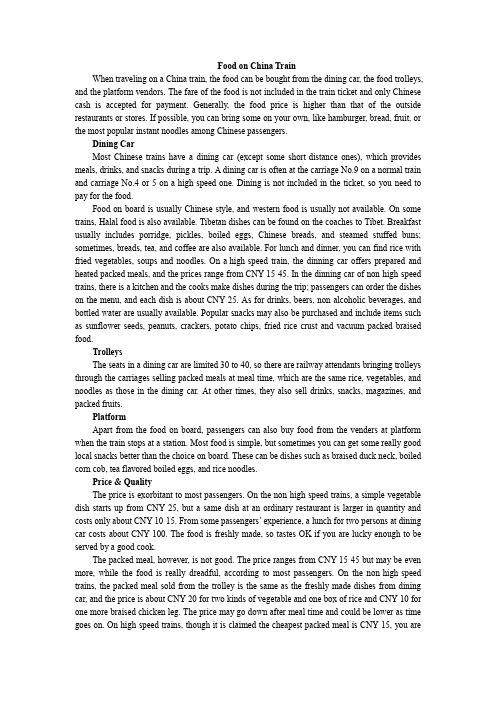
Food on China TrainWhen traveling on a China train, the food can be bought from the dining car, the food trolleys, and the platform vendors. The fare of the food is not included in the train ticket and only Chinese cash is accepted for payment. Generally, the food price is higher than that of the outside restaurants or stores. If possible, you can bring some on your own, like hamburger, bread, fruit, or the most popular instant noodles among Chinese passengers.Dining CarMost Chinese trains have a dining car (except some short-distance ones), which provides meals, drinks, and snacks during a trip. A dining car is often at the carriage No.9 on a normal train and carriage No.4 or 5 on a high-speed one. Dining is not included in the ticket, so you need to pay for the food.Food on board is usually Chinese style, and western food is usually not available. On some trains, Halal food is also available. Tibetan dishes can be found on the coaches to Tibet. Breakfast usually includes porridge, pickles, boiled eggs, Chinese breads, and steamed stuffed buns; sometimes, breads, tea, and coffee are also available. For lunch and dinner, you can find rice with fried vegetables, soups and noodles. On a high-speed train, the dinning car offers prepared and heated packed meals, and the prices range from CNY 15-45. In the dinning car of non-high-speed trains, there is a kitchen and the cooks make dishes during the trip; passengers can order the dishes on the menu, and each dish is about CNY 25. As for drinks, beers, non-alcoholic beverages, and bottled water are usually available. Popular snacks may also be purchased and include items such as sunflower seeds, peanuts, crackers, potato chips, fried rice crust and vacuum packed braised food.TrolleysThe seats in a dining car are limited 30 to 40, so there are railway attendants bringing trolleys through the carriages selling packed meals at meal time, which are the same rice, vegetables, and noodles as those in the dining car. At other times, they also sell drinks, snacks, magazines, and packed fruits.PlatformApart from the food on board, passengers can also buy food from the venders at platform when the train stops at a station. Most food is simple, but sometimes you can get some really good local snacks better than the choice on board. These can be dishes such as braised duck neck, boiled corn cob, tea flavored boiled eggs, and rice noodles.Price & QualityThe price is exorbitant to most passengers. On the non-high-speed trains, a simple vegetable dish starts up from CNY 25, but a same dish at an ordinary restaurant is larger in quantity and costs only about CNY 10-15. From some passengers’ experience, a lunch for two persons at dining car costs about CNY 100. The food is freshly-made, so tastes OK if you are lucky enough to be served by a good cook.The packed meal, however, is not good. The price ranges from CNY 15-45 but may be even more, while the food is really dreadful, according to most passengers. On the non-high-speed trains, the packed meal sold from the trolley is the same as the freshly-made dishes from dining car, and the price is about CNY 20 for two kinds of vegetable and one box of rice and CNY 10 for one more braised chicken leg. The price may go down after meal time and could be lower as time goes on. On high-speed trains, though it is claimed the cheapest packed meal is CNY 15, you arealways informed that the cheapest has already been sold out and only the dearer ones costing CNY 30 or CNY 45 are available. The worst thing is they often taste bad. So the point we wish to convey is that you should not expect too much from the catering arrangement on railway coaches.What Chinese Passengers Eat on TrainMost Chinese passengers, however, prefer to bring their own food and eat in their carriages. If you travel a lot in China, you must notice that most Chinese passengers take an extra plastic bag full of food. What’s inside their bags? There are instant noodle cups, fruits, bottled water (or just a bottle), and snacks mentioned above. To Chinese travelers, the meal on board is expensive and unpalatable. It is not surprising that the prices for drinks, snacks and fruits on board are twice or three times higher than usual. Boiled water is readily available for free in each carriage, so instant noodle cups are popular with most Chinese rail travelers, although it is said to be an unhealthy fast food. However, when everyone around you is eating their noodles filling the whole carriage with the same aroma, a cup of noodles is probably the best choice to satisfy your appetite. Sunflower seeds and peanuts are their favorite with the locals to kill time.Suggestions for Foreign Passengers1. Only take bottled water or simply a bottle (you can get free boiled water in the carriages) if you take a short-distance trip. If your happen to travel at meal time, take some snacks and have a good meal after arriving at your destination.2. If you are planning to have a meal at the dining car, try to go there as early as possible, because it will be very crowded at meal time.3. Instant rice and noodles are easy and recommended as train food, if you decide to bring your own.4. Sandwiches, bread, milk, eggs, and fruits are good choices for those who are not used to Chinese dishes. Many railway stations have fast food chain restaurants, such as KFC, McDonald, and Subway, so you can buy items there before boarding. Fresh fruits are popular as they provide both energy and water. Railway attendants pushing the trolley through carriages also sell packed fresh fruits.5. Don’t eat too much and try to avoid the food that is hard to digest, especially during a long trip. You won't move a lot, so your digestive system is inclined to work more slowly than usual. Take hand sanitizer with you and remember to wash your hands before eating.6. Bring a bottle that can take hot water. Some foreigners may be not used to the water in China, but boiled water is better than cold bottled water during a long trip.7. Should you be interested, you can try the local food from the platform. We list below particular items available at specific stations for your information:。
铁路客运英语教学工作计划
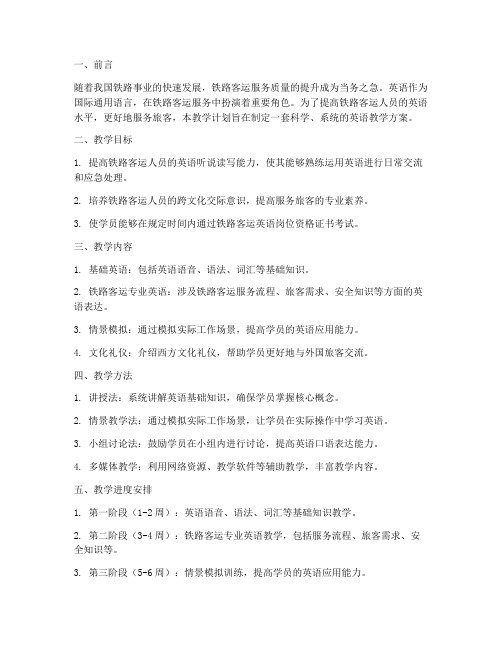
一、前言随着我国铁路事业的快速发展,铁路客运服务质量的提升成为当务之急。
英语作为国际通用语言,在铁路客运服务中扮演着重要角色。
为了提高铁路客运人员的英语水平,更好地服务旅客,本教学计划旨在制定一套科学、系统的英语教学方案。
二、教学目标1. 提高铁路客运人员的英语听说读写能力,使其能够熟练运用英语进行日常交流和应急处理。
2. 培养铁路客运人员的跨文化交际意识,提高服务旅客的专业素养。
3. 使学员能够在规定时间内通过铁路客运英语岗位资格证书考试。
三、教学内容1. 基础英语:包括英语语音、语法、词汇等基础知识。
2. 铁路客运专业英语:涉及铁路客运服务流程、旅客需求、安全知识等方面的英语表达。
3. 情景模拟:通过模拟实际工作场景,提高学员的英语应用能力。
4. 文化礼仪:介绍西方文化礼仪,帮助学员更好地与外国旅客交流。
四、教学方法1. 讲授法:系统讲解英语基础知识,确保学员掌握核心概念。
2. 情景教学法:通过模拟实际工作场景,让学员在实际操作中学习英语。
3. 小组讨论法:鼓励学员在小组内进行讨论,提高英语口语表达能力。
4. 多媒体教学:利用网络资源、教学软件等辅助教学,丰富教学内容。
五、教学进度安排1. 第一阶段(1-2周):英语语音、语法、词汇等基础知识教学。
2. 第二阶段(3-4周):铁路客运专业英语教学,包括服务流程、旅客需求、安全知识等。
3. 第三阶段(5-6周):情景模拟训练,提高学员的英语应用能力。
4. 第四阶段(7-8周):文化礼仪教学,提升学员的跨文化交际能力。
5. 第五阶段(9-10周):复习巩固,准备铁路客运英语岗位资格证书考试。
六、考核方式1. 平时成绩:包括课堂参与、作业完成情况等。
2. 口语测试:考察学员的英语口语表达能力。
3. 笔试:考察学员的英语基础知识、专业知识和文化礼仪知识。
4. 铁路客运英语岗位资格证书考试:检验学员的综合能力。
七、总结本教学计划旨在通过科学、系统的教学方法,提高铁路客运人员的英语水平,为我国铁路客运事业的发展贡献力量。
- 1、下载文档前请自行甄别文档内容的完整性,平台不提供额外的编辑、内容补充、找答案等附加服务。
- 2、"仅部分预览"的文档,不可在线预览部分如存在完整性等问题,可反馈申请退款(可完整预览的文档不适用该条件!)。
- 3、如文档侵犯您的权益,请联系客服反馈,我们会尽快为您处理(人工客服工作时间:9:00-18:30)。
Abbreviation n.缩写,缩写词
Character n.汉字
Brief adj.简短的;短暂的
Letter n.字母
Normal adj.正常的,正规的;标准的
Temporary adj.临时的
Electricmultipleunits(EMU) 动车组
W1:The ancient culture, the friendly people and the terrific food.
W2:The exciting atmosphere of change anddevelopment.
8.C:What was your impression of China?
背句子
提问
讲授
讲授
多媒体
练习
情景模拟
讲授
多媒体
教学环节
主 要 授 课 内 容
教学手段
一、课前准备
二、复习巩固
三、导入新课
四、新课讲授
五、课堂小结
五、布置作业
六、课后反思
清点人数,填写教师日志。
默写句子:
1.中国是一个迷人的国家。他对实际的贡献是巨大的。
2.中国人热情好客,亲切友好。
上一周,我们学习了旅客列车的作为等级,今天,我们再来看一下旅客列车的类型,这些内容都是我们作为列车员必须掌握的内容,所以希望同学们在课堂上认真做好笔记。
2.C:What do you think of the Chinese?
W:Chinese are very hospitable and kind-hearted.
3.C:What are your feeling about life in China?
W:Life in China is so different from life in my country.
12.C:Where have you been?
W1:I`ve been to Beijing and Shanghai. They are very impressive.
今天我们学习了中国的文化,中国人的相关表达及对话,同学们一定要张口说,开口练,否则学的英语就是哑巴英语,作为服务行业的工作人员,英语口语也是一门非常有用的知识与能力。
W1:The pollution.
W2:I hate the way people spit and litter. It really turns me off.
11.C:What do you find interesting aboutlife in China?
W1:There are so many people and so many different from western culture.
W2:It`s really proof of the China`s greatness and wisdom.
6.C:What do you want to know about China?
W1:I want to know more about tቤተ መጻሕፍቲ ባይዱaditional Chinese medicine.
2.New words and Expressions 生词和短语
Train n.火车,列车
Principal n.负责人;校长;首长
Identification n.辨认;鉴定;证明
Alphabetic adj.照字母顺序的
Numeric adj.数字的
Indicate vt.指出,显示;象征;预示;
C-Chinese 中国人 W-westerner 西方人
1.What do you think of China?
W1:China is a fascinating country. It has a lot to offer the world.
W2:I don`t know a lot about China yet, but I`m eager to learn.
Unit two passenger Train Classes
1.Phonetics 语音
Vowels 元音
/e/ --/tet/ /ded/
/?/--/k?p/ /m?p/
Consonants 辅音
/t/--/ti:/
/d/--/di:/
/n/--/ni:/
/m/--/mi:/
/?/--/he?/
4.C:How do you like the Great Wall?
W1:It`s the most amazing thing I`ve ever seen!
5.C:What do you think of the Forbidden City?
W1:I feel like I am walking through history.
W2:I want to know about opportunities for my business.
W3:I really want to know more about the English education in China.
7.C:What attracts you the most about China?
铁路客运英语教案
教学环节
主 要 授 课 内 容
教学手段
一、课前准备
二、复习巩固
三、导入新课
四、新课讲授
四、课堂小结
五、布置作业
六、课后反思
清点人数,填写教师日志。
情景对话:
找同学来情景对话,对上节课所学内容进行复习巩固。
中国的文化源远流长,中国人也是好客又热情,关于中国文化一些最基本的英语表达,我们必须要了解,所以今天我们来学习关于中国,中国文化和中国人。
请告诉我,我去广州该坐那趟车?
2.I wonder if you could help me with my luggage.
不知您能否帮我拿一下行李?
3.Will you please tell me how to check my luggage for Hangzhou?
(2)Mini Talks 短对话
W1:China was much more modern than I expected.
The cities are filled with skyscrapers.
W2:It`s very different from what I expected. It`s not at all like what I thought.
谢谢您为我买的车票。
4.I`m very sorry.
很对不起。
5.Pardon?
请再说一遍好吗?
6.Sorry to trouble you.
对不起,麻烦您一下。
B. Requests 请求
1.Please tell me which train I should take for Guangzhou.
3.Everyday English 日常英语
(1)Learn to say 学着说
A. Thanks & Apologies 感谢和道歉
1.It`s very kind of you.
您真好!
2.Thank you for your help.
谢谢您的帮助。
3.Thank you for the trouble you have taken to get me the ticket.
W2:Ancient culture and moderndevelopmentexist side by side.
W3:There are so many different cities and so many different customs. Every city has a unique personality.
很抱歉让您久等了。
B:Noproblem.
没关系。
本节课,学习了跟列车类型相关的单词和短语,课后同学们要把重点词语及语句记下来。
课后第1题
提问
讲授
讲授
多媒体
练习
情景模拟
讲授
多媒体
1.A:Thank you very much.
非常感谢。
B:You are welcome.
不客气。
2.A:Many thanks.
多谢。
B:With pleasure.
很荣幸能给您帮忙。
3.A:I`m sorry.
对不起。
B:It doesn`t matter.
没关系。
4.A:Sorry to keep you waiting.
9.C:What do you like best about China?
W:The hospitality of the Chinese.
W2:The history and unique features of its different
Cities.
10.C:What do you dislike most about China?
